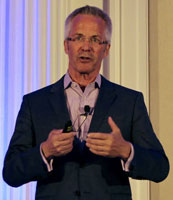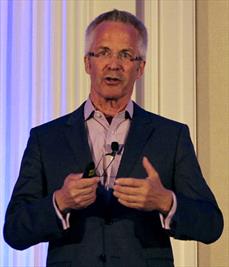

VIN News Service photo
Lawyer and lobbyist Mark Cushing is well-known in the accreditation arena for having successfully ushered several programs through the process. The University of Arizona's budding veterinary school is among his clients.
Round two is under way in the University of Arizona's quest to earn accreditation for what could be the nation's 31st veterinary medical program.
Members of the Council on Education gathered Saturday at American Veterinary Medical Association headquarters in Schaumburg, Illinois, where reports circulate that a site team will visit the UA Kemper and Ethel Marley Foundation Veterinary Medical and Surgical Program in May or early June 2019.
The visit signals a first step toward ending a series of disappointments for the program in its quest for accreditation. "We expect to hear from the COE after their spring 2018 meeting," said Dr. David Besselsen, interim dean of the program.
The meeting ended Tuesday. It's possible that members of the COE — the sole programmatic accreditor of veterinary education in the United States and Canada — could consider the site team's findings when the group gathers in September 2019.
UA aims to open in fall 2020, the latest target date in a series of prospective openings that did not materialize.
For UA to welcome its inaugural class, the program needs a letter of reasonable assurance, the first step in the accreditation process. Reasonable assurance is issued by the COE if evaluators believe a program has a feasible plan for achieving full accreditation. The designation provides students with access to professional loans under Title VII of the U.S. Public Health Act.
"Opening is subject to a COE decision; it's up to them," Besselsen said. "If they grant us reasonable assurance, we will admit 100 students per class."
UA has actively sought accreditation since 2013. Officials initially aimed to open in fall 2015, with development of the program jumpstarted by a $9 million grant from the Kemper and Ethel Marley Foundation, a charity that funds health-care operations. UA also has received an $8 million appropriation from the Arizona Legislature. The money is slated to retrofit a 30,000-square-foot building in Oro Valley, home of UA's prospective veterinary headquarters.
Besselsen declined to disclose how much UA is investing to fully develop the fledgling program, calling it a "dynamic process." UA's veterinary college will not include a traditional teaching hospital. Rather, it would employ a hybrid distributive model that sends students through clinical training at local practices.
"There are many moving parts," he said. "... I have about six projects ongoing right now to help the infrastructure. Again, [it's all] pending COE approval."
UA's plans for a veterinary program has encountered a variety of setbacks. Chief among them is the COE's rejection of UA in 2016, based on findings that the program failed to meet four of the agency's 11 accreditation standards. The deficiencies included a lack of evidence of the program's long-term financial viability; inadequate staffing and recruiting plans; lack of a high-quality research program; and concerns that students might not have adequate access to learning opportunities.
UA appealed, but a hearing panel appointed by the AVMA Board of Directors sided with the COE in March 2017.
To help ensure that UA's second attempt at accreditation has a more favorable outcome, the program has hired Mark Cushing, a lawyer and policy advisor who's successfully ushered veterinary medical programs at Ross University, Lincoln Memorial University and the National Autonomous University of Mexico through the accreditation process. A contract between UA and Cushing, obtained by VIN News via a freedom of information query, began Feb. 15, 2017 and continues until the COE site team conducts its next visit. Thus far, UA has paid the consultant $154,000. Under the contract, which has since been revised to include a pay increase, Cushing's $10,000-a-month fee will continue until one month before the COE's next site visit, when he will earn $12,000.
Asked about the relationship and how UA can afford Cushing's services, Besselsen said he didn't have a role in hiring him. The contract predates Besselsen's appointment as interim dean in September. "I don't know who made that decision," he said. "I was brought on after he was retained. I work closely with him, obviously. He's been a strong advocate and very insightful."
Besselsen declined to outline changes that have been made to the program since the COE conducted its first comprehensive site visit in January 2016. Reached by phone Tuesday, Cushing was tight-lipped, too: "I'm not going to discuss in any detail what specifically has changed. ... It's a methodical process to launch a veterinary college.
"It's not a press conference; it's not a newsbyte," he added.
Bits of insight, however, appear in an email Cushing sent on May 24, 2017 to Laura Todd Johnson, UA senior vice president for legal affairs and general counsel. Obtained by VIN News via the freedom of information request, Cushing asked for a raise in his fees to "manage the COE relationship" and build support for the program among "external stakeholders, including elected officials." Cushing outlined his efforts to strengthen the program and handle its bid for accreditation in a list of his job tasks that include:
- building strategic relationships in the profession, academia and the COE "echo chamber" to support UA's initiative;
- recruiting a larger pool of clinical sites with staff support;
- managing the recruitment of a permanent dean;
- managing the COE's next comprehensive site visit;
- working with student outreach to build interest in the new veterinary program;
- working with the provost, interim dean and staff to develop the program's facilities; and
- managing and drafting the program's self-study for the COE.
"I am confident we will reach our goal and create a national caliber, innovative and Arizona-centric veterinary school," Cushing wrote. "Thanks for the opportunity, and let me know your thoughts about the proposed adjustment."
Johnson responded by email on June 1, praising Cushing's work. "Your proposal is approved," she replied. "Your work on our behalf has been excellent and your revision is in keeping with the amount of time we have been requiring of you and the range of tasks you have been working on for us. We are all especially pleased to have not only your expertise and professionalism, but your intuitive insight and unparalleled responsiveness."
With Cushing's business anchored in the development of new schools, he's been a vocal counter to concerns in the veterinary community that the recent expansion in veterinary academia aggravates problems in the profession: enormous educational debt and the prospect that more graduates will feed an oversupply and/or maldistribution of veterinarians.
Workforce-related anxieties reared among veterinarians in Arizona several years ago when it became clear that UA wasn't alone in its efforts to develop the state's first veterinary medical school. While plans to offer veterinary education at UA had been an on-and-off aspiration since the 1950s, another university beat them to opening. In 2014, Midwestern University admitted 100 students to its new program in Glendale, 130 miles north of the UA campus in Tucson.
Midwestern's presence in veterinary education initially slowed UA's momentum due to concerns from veterinarians that local markets might be unable to absorb graduates from two programs. "We haven't seen the first class come out of Midwestern yet," said Dr. Michael Ames, who left private practice years ago to start a pet cremation business that serves Southern Arizona. "How many will stay in-state? How many will leave? No one knows yet."
Midwestern's inaugural class graduates this spring.
Dr. Richard Panzero, who represents Arizona as an alternate delegate to the AVMA and owns a practice in Tucson, asserts that the state's healthy economy has put workforce concerns to rest. "When the recession hit, veterinarians in practice felt they didn't need more competition," he recalled. "But now, there are probably more ads for the employment of veterinarians than any time in the past."
Panzero noted that a recent effort by the AZVMA to quantify the job market showed that Arizona needed 45 to 50 new veterinarians per year. "That was our calculation, based on the number of people seeking licensing in the state and trying to account for attrition. Those numbers are fairly stable, maybe an upswing. It's our gut assessment," he said.
Speaking of UA's contract with Cushing, Panzero observed: "His expertise was viewed as being advantageous in getting a letter of reasonable assurance. I don't think people like Mark come cheap, and I think they're making good use of him."
Panzero added that he's a proponent of the UA's attempts to lower tuition costs, which are rising at rates that far outpace inflation. Many new veterinary graduates have educational debt totaling more than twice what they can expect to earn in their first year of employment. UA, he said, aims to offer education that's more affordable.
"There are some positive things about it," he said of the UA program. "They think outside the box. The traditional model, if you look at it, has not done all that well for today's profession. There's a tremendous amount of student debt … and everyone would welcome a substantial reduction in tuition."
While Besselsen said tuition has not yet been determined, he confirmed that the program is intended to deliver a more affordable option for earning a DVM, namely by accepting more undergraduate candidates who've completed pre-professional requirements rather than those with bachelor's degrees. Dr. Shane Burgess, Besselsen's predecessor and dean of the College of Agriculture and Life Sciences, said during an August 2016 interview that UA intends to populate its veterinary student body with Arizonans so they get the benefit of in-state tuition, although there will be seats dedicated to higher-paying out-of-state students. He said that in-state tuition would reflect national averages for veterinary education, which are in the range of $28,000 a year.
UA also aims to shorten the road to earning a DVM by shaving time off traditional school breaks. This will allow the program to be compressed into three calendar years rather than four, as is the norm among other American institutions offering veterinary medical education.
Besselsen pointed out that under the UA system, veterinary graduates may enter the workforce earlier than they can at other programs, which should save them money. "My hope for this program is to produce competent veterinarians who can serve the needs of our state and citizens," he said. Today's graduates, he added, "carry a tremendous amount of debt."
AVMA economists report that 2017 graduates accrued an average $138,066 in education debt, which is nearly double the annual salaries typically paid to new veterinarians. The debt figure does not factor data from Midwestern, which has yet to graduate its first class, and also is skewed by a growing number of seemingly affluent students who can afford to pay upfront for their education.
The debt-to-income imbalance is "the anvil around the profession's neck," Ames said. In addition to his crematory business, he represents Arizona as a delegate to the AVMA, where student debt is a recurring topic of debate.
"If UA can pull off a good program and the average student can get through and borrow less than $100,000, God, we have to give that a try," Ames said.